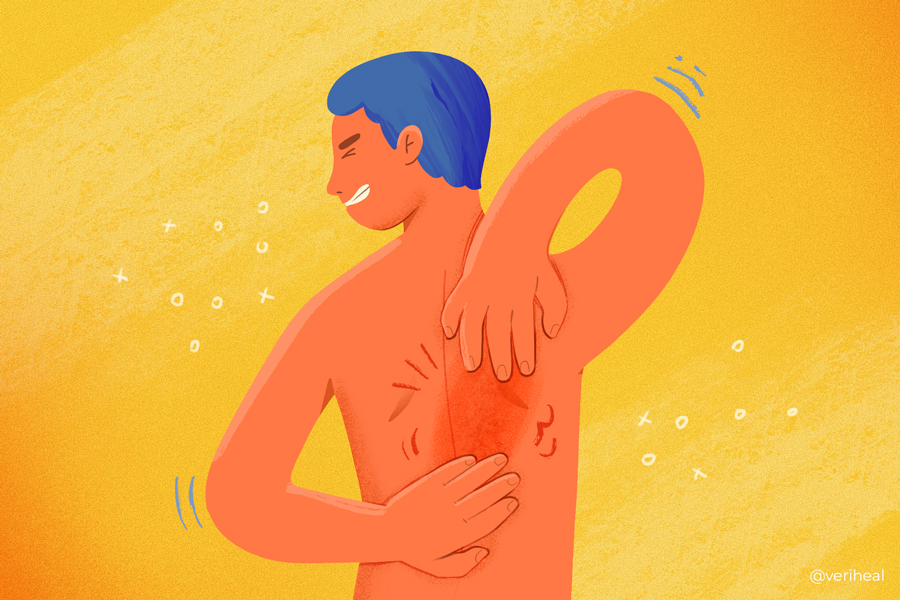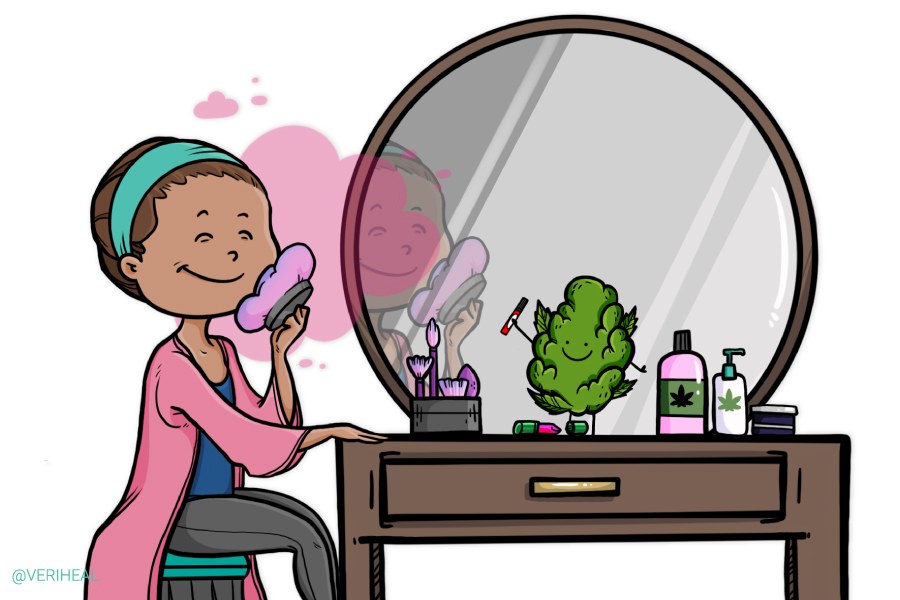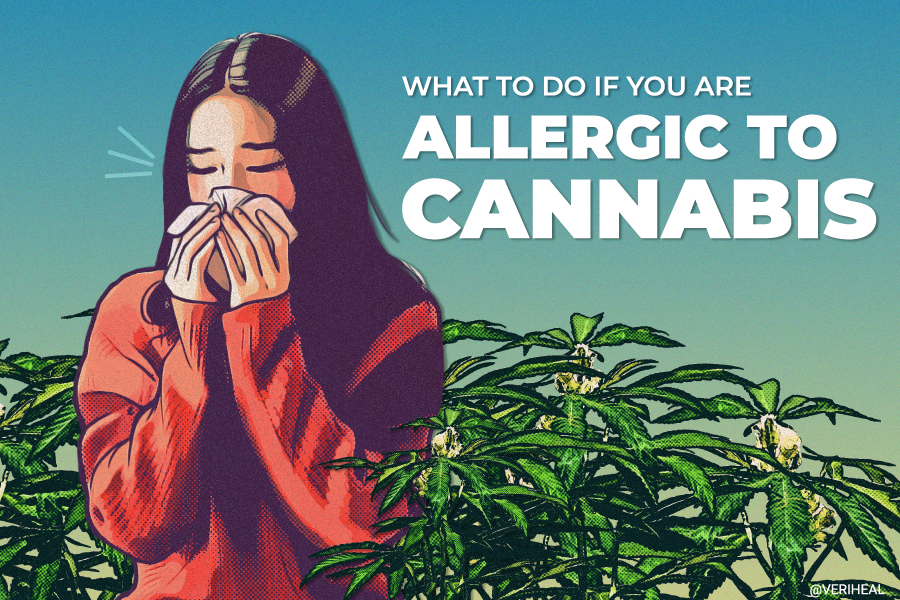Pruritus & Chronic Itch: Can Medical Marijuana Help?

- What Causes Itching
- Medical Marijuana Delivery Methods for Chronic Itch Relief
- Chronic Itching and Medical Marijuana
- Skin Conditions that Cause Pruritus
No one likes itching, especially when it is on your back or other hard-to-reach areas of your body. But for many people who deal with chronic itching on the regular, the incessant itching can be widespread over the entire body and affect their quality of life. Chronic itching, also known as pruritus, is often a symptom of an underlying particular condition that needs to be treated. Unfortunately, many things can cause itching in addition to skin conditions.
Many doctors attempt to help stop the itch by prescribing emollients, topical anesthetics, menthol, glucocorticoids, antihistamines, and some neuroactive medications, but they have not found that patients always get complete or consistent relief (1). However, there may be hope for calming pruritus by using medical marijuana.
Medical marijuana, also known as cannabis, contains over 100 naturally occurring cannabinoids. The most well-known cannabinoids are Δ9-tetrahydrocannabinol (THC) and cannabidiol (CBD). After these cannabinoids are ingested into our body, they interact with a bodily system called the endocannabinoid system (ECS). The ECS consists of fat-based neurotransmitters called endocannabinoids that interact with the cells in our body as well as the nervous system via cannabinoid receptors CB1 and CB2 that are influenced by the endocannabinoids. Plant-based cannabinoids, called phytocannabinoids, can also interact with our body through CB1, CB2, and more receptor types. It is thought that the ECS is responsible for maintaining homeostasis, how we perceive pain, as well as plays a role in our digestion. It is also responsible for reducing inflammation in our body as well as many other functions.
Because we perceive itching in our skin, let’s look at how medical cannabis and its cannabinoids work to directly impact our skin. The most well-known endocannabinoid players include anandamide (AEA) and 2-arachidonoylglycerol (2-AG). These endocannabinoids are found in large numbers within skin cells called fibroblasts and keratinocytes (21). Additionally, both CB1 and CB2 receptors can be found in keratinocytes, skin nerve fibers, melanocytes (produce pigment or melanin), sweat glands, sebaceous oil glands, and hair follicles (3).
Transient receptor potential (TRP) receptor channels, including transient receptor potential vanilloid type 1 (TRVP) channels, also play a role in how our skin can utilize medical cannabis, though it is not considered part of the ECS (3). TRP receptors are also responsible for the formation and maintenance of the skin barrier along with influencing the immune system of the skin and modulation inflammation. When the skin barrier is broken or inflamed, people can experience itching, skin allergies, cracking, and bleeding (43).
What Causes Itching?
Have you ever wondered what causes you to itch? It turns out researchers now can answer that question. Nerve cells in the skin are considered a type of sensory neuron (49). Sensory neurons are nerve cells that can be activated by sensory inputs from our environment. For example, if you touch something hot, the skin nerves initially feel the heat, but then transfer that information up through our nervous system and into our brains, the location that ultimately tells us about the hot sensation.
We do know that TRPV channels, which also play a role in the ECS, can be activated by hot temperatures and capsaicin which is found in spicy peppers (40). In 2013 a team of researchers wanted to explore itch further and did so by trying to induce itch through histamines (a chemical produced in the body that is responsible for allergic reactions) in mice who lacked TRPV1 channels (25).
It turns out these mice without TRPV1 channels did not feel itch from substances that activate histamines, but when they were injected with a molecule produced in our bodies called natriuretic polypeptide b (Nppb), they began to itch (25). These researchers found that a select group of TRPV1 neurons found near the spine of these mice is responsible for producing Nppb which is responsible for triggering the initial itch response. Another molecule called GRP (gastrin-releasing peptide) also causes itching, and is thought to act second in the itch response after Nppb. The itch sensation then travels up sensory nerves that produce and receive Nppb and GRP, and then goes to the brain to tell us about the itch.
While this research was conducted on mice, researchers of this study believe that we can turn off itch through targeting Nppb in humans as well. Nppb has also been shown to be necessary for the heart, kidneys, and other organs to function, which leads researchers to believe they need to find a safer target to stop pruritus in humans (40).
These researchers have also found that other molecules produced in the body, somatostatin and an immune signaling molecule called oncostatin M (OSM) play a role in how itching is perceived as well (38) (39). Some nerves have TRPV1 receptors that make Nppb, and some intermediate nerves have GRP receptors also produce somatostatin and Nppb, which amplify the itch response. Somatostatin can affect TRPV1 receptors and cause more itching (17). Because of the role TRPV1 receptors play in skin nerve fibers as outlined above, this mechanism can potentially be modulated by cannabinoids, though this research is still in its infancy.
Research literature for chronic itching suggests that cannabinoids may be good at relieving itch due to its ability to turn on and off skin nerves as well as its ability to positively impact keratinocytes (the primary skin cell in the upper layer of skin) and mast cells that are responsible for immune responses (1). These functions are thought to work through CB1, CB2, or TRP channels as mentioned in detail above.
It is believed that medical cannabis can relieve itching through CB1 receptors that activate anti-itch and pain-relieving effects in our peripheral nerves and central nervous system, which includes the brain and spinal cord (1). Both CB1 and CB2 receptors are responsible for anti-itch and pain relief in our peripheral nerves, or rather, nerves that are not part of our spinal cord or brain.
Medical Marijuana Delivery Methods for Chronic Itch Relief
The different delivery methods of cannabinoids affect our bodies differ from each other due to bioavailability and the route of administration. Cannabinoids easily bind to fat when they are ingested or utilized by our body (lipophilic), and these fats make it easier to get the positive benefits (1). Raw cannabinoid acids like CBDA and THCA have some absorption in water and can increase endocannabinoids.
Inhaling cannabis by vaping or smoking is one of the most popular methods of ingestion, but unfortunately, there is not a lot of data to support using it for itching (1). There is potential hope that it may help itching though as it helps relieve chronic pain through similar ECS pathways.
However, topical ointments, lotions, and transdermal patches show a lot of promise for treating skin disorders, including itching. This is because they have higher efficacy and safety profiles and most studies focusing on skin issues utilize these delivery methods (1). This is because topical products can absorb directly into the skin and activate TRP, CB1, and CB2 receptors. TRP receptors are considered ionotropic cannabinoid receptors which control nociception or pain in our skin (10). This is partly why researchers believe that cannabinoids are so effective in relieving the itch in eczema.
THC is known for activating CB1 receptors as well as for its ability to reduce pain, which can result from inflammation, scratching, and other defects on the skin (3). Anandamide can also target CB1 and CB2 receptors and potentially contribute to itching reduction. Some cannabinoids like CBD and endocannabinoid-like molecules like PEA can increase the bioactivity of anandamide and also potentially reduce itching that way (10). On the other hand, CB2 receptors in the skin are thought to target immune function and reduce inflammation, which can result from itching and scratching the skin.
Oral ingestion of medical marijuana through tinctures, capsules, or edibles is also preferred because the doses are easily measured and contain standard concentrations of THC and other cannabinoids. This is presuming the product has been third-party tested for dosing and safety. Because cannabinoid receptors and their roles in reducing itching and inflammation work both through our central nervous system and peripheral nerves, researchers believe that oral ingestion of cannabis is an optimal delivery method for those with chronic pruritus (1).
It is important to note that edibles go through a first-pass metabolism in our liver, so the effectiveness and how long it takes to begin acting varies by person and how well your body converts THC to 11-hydroxy-THC. This converted form is about 4 times more psychoactive than regular THC and is the reason why edibles are so strong, long-lasting, and easy to take too much of. Edibles can begin working between 45 minutes and 2 hours, but it can take up to 6 hours to reach peak blood plasma levels. Their effects may last around 6-30 hours.
Chronic Itching and Medical Marijuana
There are several causes of pruritus and not all of them have to do with the skin. It is always important to talk with your doctor if you have severe itching with or without a rash for more than two weeks as it may also be a symptom of a more serious underlying condition that needs medical intervention (24). It is also important to see a doctor if the itching affects the whole body, comes on suddenly without explanation, is accompanied by other symptoms, or starts to affect your quality of life. Whenever you have a health concern, you should contact your provider.
The possible causes of pruritus can be broken down into the categories below. Please keep in mind that this list does not include all the causes of itchiness. Idiopathic pruritus is diagnosed when the source of itching cannot be found (45).
Skin Conditions That Cause Pruritus
Chronic itching is usually associated with skin disorders that often include dry skin and rashes (50). Some skin conditions that have been attributed to itching include (50):
- Atopic dermatitis, a type of eczema
- Psoriasis
- Shingles/Chickenpox
- Hives (51)
- Dry skin or xeroderma
- Parasitic skin infections (51)
- Insect bites
- Fungal skin infections such as yeast infections
- Allergic contact dermatitis (51)
- Skin ulcers & wounds leading to infection
- Rosacea
- Xeroderma pigmentosum
- Epidermolysis bullosa
- Darier’s Disease
Please check out the above conditions to learn more about how medical marijuana may help provide you relief.
Irritation and Allergic Reactions
The skin serves as the primary barrier of protection for our bodies, so it is no surprise that it can be easily irritated at times. Many irritants are items that we interact with daily, so it is important to note any changes in the products that you use that may be contributing to pruritus. Irritants of the skin can be different for each person, but they may include (24):
- Chemicals, such as cleaning agents and detergents
- Personal care products including soaps and lotions
- Poison ivy
- Wool and other animal-based fabrics
Allergic reactions can also cause itching and rashes of the skin. Even if the allergic object may touch the skin and doesn’t cause symptoms, it is possible that when it is ingested, you will experience severe itching or a rash. Common causes of the signs of allergic reactions on the skin include:
- Poison ivy (24)
- Cosmetics (24)
- Reactions to medications including: opioids, morphine, chemotherapy, ACE inhibitors, vitamin A, and some antibiotics (45)
- Food allergies (52)
- Allergies to fragrances in perfumes, lotions, or other products (53)
- Nickel, a type of metal found in jewelry, belt buckles zippers, and more is the most common form of contact dermatitis, or skin reaction (53)
- Insect bites
Can Cannabis Help Allergic Itch?
According to a 2020 review in the Journal of the American Academy of Dermatology, “increased endocannabinoids in neural tissue specifically decreases histaminergic itch and direct effects of cannabinoids on neuronal receptors increase the nociceptive threshold (1).” Simply put, itch caused by an allergic reaction can be reduced when endocannabinoids in the skin are increased. Pain sensed in the skin is also reduced by cannabinoids as well.
This has been tested in studies that applied endocannabinoids directly on the skin. A 2002 study in Inflammation Research tested this by applying a cannabinoid receptor agonist, or activator, called HU210. This was tested against histamine (which is normally released during an allergic reaction) that was applied to the skin of 18 participants (9). The results showed that activating cannabinoid receptors in the skin during these allergic reactions was able to calm down the nerves’ response to histamine.
The cannabinoids in cannabis may also be applied topically to increase the activation of endocannabinoid receptors in the nerve fibers of the skin. Much like the study above, CBD and cannabinoid acids can increase endocannabinoid levels in the skin and potentially help relieve itching. Overall, data suggest that activity on CB1 has more anti-itch activity, therefore a type I chemovar with more THC than CBD could be better for alleviating itching.
Internal Diseases
There are several reasons that you may be itchy that are caused by other health issues in the body and are not just related to the skin. Doctors see pruritus commonly in patients who have liver diseases, and they think it may be caused by the buildup of bile acids in the skin and blood (45).
It is also quite common in patients who are undergoing dialysis, are in kidney failure, have kidney stones, or have other issues with their kidneys. Please check out our page on kidney disease and dialysis for more information about treating chronic itching if you fall into this category.
It is important to note that if you have pruritus caused by internal diseases the treatment to soothe your itching may not simply be at the skin level, but it will also need different interventions to treat the root disease. Some additional internal disorders that can contribute to chronic itching include (45):
- Kidney disease
- Renal Failure
- Cholestasis, a type of liver disease
- Hepatitis
- Cancers including- lung, stomach, colon, prostate, pancreatic, skin and breast cancer
- Leukemia (54)
- Sipple syndrome (54)
- Chronic fatigue syndrome (54)
- Fibromyalgia (54)
- Adrenal gland issues (54)
- Diabetes
- Sjogren’s syndrome
- HIV/AIDs
- Pregnancy
- Lymphoma
- Lupus (54)
- Mastocyotosis
- Polycythemia vera
- Iron-deficient anemia
- Thyroid disorders
- Leptospirosis (54)
- Multiple endocrine neoplasms (MEN) syndrome
- Shingles
Internal Disease-induced Pruritus and Medical Cannabis
There are some studies that discuss using cannabis for chronic itching that is caused by internal diseases such as liver issues, kidney disease, and diabetes. While medical marijuana has shown potential in reducing pain, and slowing inflammation in these diseases, chronic itching is no exception.
A 2021 case study published in JAMA Dermatology chronicled the journey of a patient who was suffering from pruritus due to diseased bile ducts of the liver. This disease, called primary sclerosing cholangitis, causes itching due to irritating chemicals under the skin that are normally released with the production of bile from the liver (21).
According to this study, there is a lack of US Food and Drug Administration-approved treatments for chronic itching, but the patient was able to successfully use medical cannabis to relieve their chronic itching (21) (30). After trying topical and oral corticosteroids, naltrexone, and phototherapy, the patient began using medical marijuana with 18% THC by smoking or using a tincture. Ten minutes after initial administration, her worst itch rating decreased from 10 to 4. At both 16-month and 20-month follow-ups, the itch score decreased to zero.
Upwards of 50% of patients with chronic kidney disease that are undergoing dialysis also experience chronic pruritus (1). There is a decent amount of research supporting the use of medical marijuana for this patient population. One study tested a topical application of a derma-membrane (DMS)-based lotion in combination with the endocannabinoid AEA and endocannabinoid-like molecule Palmitoylethanolamide (PEA) (34). After 3 weeks of treatment, 38.1% of patients saw a reduction in pruritus and 81% of patients experienced a reduction in xerosis or dry skin.
Though this study focusing on uremic itch didn’t directly use plant-based cannabis, it does show us positive results for prompting more research for cannabis use in this area as cannabis is an easy way to increase endocannabinoids in the body as well as directly stimulate the ECS in the skin.
Nerve Disorders
Neurogenic pruritus is caused by brain diseases or injuries to the brain. This itching typically occurs in attacks suddenly and it may only affect one location or one side of the body. It’s interesting to note that patients who experience neuropathy because of these medical conditions tend to experience numbness and tingling as opposed to chronic itching (45). Conditions that lead to neurogenic itching include (45):
- Multiple sclerosis
- Stroke
- Brain tumors or abscesses
- Amyotrophic lateral sclerosis (ALS) (23)
Cannabinoids and Nerve-based Itch
Typically patients who have neurological diseases as listed above experience neuropathic tingling, burning, or numbness as opposed to itching, but it does occasionally happen in multiple sclerosis and tabes dorsalis, a complication from untreated syphilis (26). While these patients are often prescribed amitriptyline, gabapentin, and antidepressants for pruritus, they do not always find relief.
A 2021 case study focused on a patient with ALS who suffered from neuropathic pruritus who experimented with using oral cannabinoids for relief (23). This patient in their 60s initially reported an itch score of seven out of ten. After cannabinoid use it decreased to three out of ten. The patient was taking capsules containing 2.43mg of THC and 2.75 mg of CBD and was able to sustain control over the chronic itching while maintaining this twice-daily regimen. Additionally, they did not experience any increases in anxiety that can sometimes occur with medical marijuana use and experienced an overall improvement in wellbeing due to decreased itching.
Psychiatric Conditions
It may not be immediately evident, but psychiatric conditions can also cause chronic itching. This is referred to as psychogenic itch and is typically the last cause to be determined as other causes must first be eliminated (5). This type of itching usually occurs on areas that are easily accessible to one’s hands, including the face, arms, legs, abdomen, thighs, upper back, and shoulders (18). Some of the big contenders in this include (24):
- Anxiety disorders
- Depression (5)
- Obsessive-Compulsive Disorder (5)
- Delusions of parasitosis (5)
- Somatoform disorders (18)
- Psychosis (18)
- Substance Abuse (18)
- Additionally, itching can be triggered by other psychological factors such as loss of a loved one, unemployment, and stress (18). You may find yourself itchy after excitement or, perhaps, being anxious trying to finish a task.
Thoughts to Consider Before Starting Medical Cannabis for Itch
Much of the research on chronic itch is in its infancy as cannabis research and in general, is newer in dermatology (10). This is why using cannabis in the skin cannot be completely recommended at this time. Research has not yet provided dermatologists with the necessary information to provide cannabis dosages or applications for the general population as individuals may respond differently to it.
It is also important to note that while topical use of cannabinoids, especially THC, does not appreciably absorb into the rest of the body through the skin, their metabolites may be able to accumulate over time which may lead to a positive drug test result despite the lack of systemic and psychoactive effects.
Additionally, medical cannabis may not be a good fit for everyone. It can cause an increase in heart rate in patients with existing heart issues. Medical cannabis can also interact with existing medications you are taking such as those for epilepsy. It is important to talk to your doctor before beginning medical marijuana treatments in general, not just for treating pruritus.
Note: Veriheal does not intend to give this as professional medical advice. Do not attempt to self-diagnose or prescribe treatment based on the information provided on this page. Always consult a physician before making any decision on the treatment of a medical condition.
1. Avila, C., Massick, S., Kaffenberger, B. H., Kwatra, S. G., & Bechtel, M. (2020). Cannabinoids for the treatment of chronic pruritus: A Review. Journal of the American Academy of Dermatology, 82(5), 1205–1212. https://www.jaad.org/article/S0190-9622(20)30120-1/fulltext
2. Adusumilli, N. C., Hazuka, E. L., & Friedman, A. J. (2021). Nanotechnology to deliver cannabinoids in dermatology. Precision Nanomedicine. https://precisionnanomedicine.com/article/24597-nanotechnology-to-deliver-cannabinoids-in-dermatology
3. Baswan, S. M., Klosner, A. E., Glynn, K., Rajgopal, A., Malik, K., Yim, S., & Stern, N. (2020). Therapeutic Potential of Cannabidiol (CBD) for Skin Health and Disorders. Clinical, cosmetic and investigational dermatology, 13,927–942. https://www.ncbi.nlm.nih.gov/pmc/articles/PMC7736837/
4. Bíró, T., Tóth, B. I., Marincsák, R., Dobrosi, N., Géczy, T., & Paus, R. (2007). TRP channels as novel players in the pathogenesis and therapy of itch. Biochimica Et Biophysica Acta (BBA) – Molecular Basis of Disease, 1772(8), 1004–1021. https://www.sciencedirect.com/science/article/pii/S0925443907000774?via%3Dihub
5. Caccavale, S., Bove, D., Bove, R. M., & LA Montagna, M. (2016). Skin and brain: itch and psychiatric disorders. Giornale italiano di dermatologia e venereologia : organo ufficiale, Societa italiana di dermatologia e sifilografia, 151(5), 525–529. https://pubmed.ncbi.nlm.nih.gov/25854671/
6. Caterina, M., & Pang, Z. (2016). TRP channels in Skin Biology and Pathophysiology. Pharmaceuticals, 9(4), 77. https://www.mdpi.com/1424-8247/9/4/77
7. Cintosun, A., Lara-Corrales, I., & Pope, E. (2020). Mechanisms of Cannabinoids and Potential Applicability to Skin Diseases. Clinical drug investigation, 40(4), 293–304. https://pubmed.ncbi.nlm.nih.gov/32060787/
8. Dobrosi, N., Tóth, B. I., Nagy, G., Dózsa, A., Géczy, T., Nagy, L., Zouboulis, C. C., Paus, R., Kovács, L., & Bíró, T. (2008). Endocannabinoids enhance lipid synthesis and apoptosis of human sebocytes via cannabinoid receptor‐2‐mediated signaling. The FASEB Journal, 22(10), 3685–3695. https://faseb.onlinelibrary.wiley.com/doi/10.1096/fj.07-104877
9. Dvorak M, Watkinson A, McGlone F, et al. Histamine induced responses are attenuated by a cannabinoid receptor agonist in human skin. Inflamm. Res. (2003). 52(6):238-45. https://pubmed.ncbi.nlm.nih.gov/12835895/
10. Eagleston, L. R., Kalani, N. K., Patel, R. R., Flaten, H. K., Dunnick, C. A., & Dellavalle, R. P. (2018). Cannabinoids in dermatology: A scoping review. Dermatology Online Journal, 24(6). https://escholarship.org/uc/item/7pn8c0sb
11. Elhag, S., Rivas, N., Tejovath, S., Mustaffa, N., Deonarine, N., Abdullah Hashmi, M., Yerneni, S., & Hamid, P. (2022). Chronic Kidney Disease-Associated Pruritus: A Glance at Novel and Lesser-Known Treatments. Cureus, 14(1), e21127. https://www.ncbi.nlm.nih.gov/pmc/articles/PMC8752116/
12. Fusi, C., Materazzi, S., Minocci, D., Maio, V., Oranges, T., Massi, D., & Nassini, R. (2014). Transient receptor potential vanilloid 4 (TRPV4) is downregulated in keratinocytes in human non-melanoma skin cancer. Journal of Investigative Dermatology, 134(9), 2408–2417. https://www.jidonline.org/article/S0022-202X(15)36970-0/fulltext
13. Garbutcheon‐Singh, K. B., & Smith, S. D. (2021). Cannabinoids interaction with transient receptor potential family and implications in the treatment of rosacea. Dermatologic Therapy. https://onlinelibrary.wiley.com/doi/10.1111/dth.15162
14. Gingold, A. R., & Bergasa, N. V. (2003). The cannabinoid agonist WIN 55, 212-2 increases nociception threshold in cholestatic rats: implications for the treatment of the pruritus of cholestasis. Life sciences, 73(21), 2741–2747. https://pubmed.ncbi.nlm.nih.gov/13679241/
15. Gingold AR, Bergasa NV. The cannabinoid agonist WIN 55, 212-2 increases nociceptive threshold in cholestatic rats: Implications for the treatment of the pruritus of cholestasis. Life Sci. (2003). https://www.sciencedirect.com/science/article/abs/pii/S0024320503006684
16. Gupta, A. K., & Talukder, M. (2021). Cannabinoids for skin diseases and hair regrowth. Journal of Cosmetic Dermatology, 20(9), 2703–2711. https://onlinelibrary.wiley.com/doi/10.1111/jocd.14352
17. Huang, J., Polgár, E., Solinski, H. J., Mishra, S. K., Tseng, P. Y., Iwagaki, N., Boyle, K. A., Dickie, A. C., Kriegbaum, M. C., Wildner, H., Zeilhofer, H. U., Watanabe, M., Riddell, J. S., Todd, A. J., & Hoon, M. A. (2018). Circuit dissection of the role of somatostatin in itch and pain. Nature neuroscience, 21(5), 707–716. https://www.nature.com/articles/s41593-018-0119-z
18. Jain, S. (2018, December 11). Problematic pruritus: Seeking a cure for psychogenic itch. MDedge Psychiatry. Retrieved February 22, 2022, from https://www.mdedge.com/psychiatry/article/77689/anxiety-disorders/problematic-pruritus-seeking-cure-psychogenic-itch
19. Kahremany, S., Hofmann, L., Gruzman, A., & Cohen, G. (2020). Advances in Understanding the Initial Steps of Pruritoceptive Itch: How the Itch Hits the Switch. International journal of molecular sciences, 21(14), 4883. https://www.ncbi.nlm.nih.gov/pmc/articles/PMC7402353/
20. Kupczyk, P., Reich, A., & Szepietowski, J. C. (2009). Cannabinoid system in the skin – a possible target for future therapies in dermatology. Experimental Dermatology, 18(8), 669–679. https://onlinelibrary.wiley.com/doi/10.1111/j.1600-0625.2009.00923.x
21. Lanese, N. (2021, April 9). A woman’s debilitating chronic itch disappeared after she started using marijuana. LiveScience. Retrieved February 22, 2022, from https://www.livescience.com/chronic-itch-cannabis-treatment.html
22. Lipman, Z. M., Labib, A., & Yosipovitch, G. (2021). Current Clinical Options for the Management of Itch in Atopic Dermatitis. Clinical, cosmetic and investigational dermatology, 14, 959–969. https://www.ncbi.nlm.nih.gov/pmc/articles/PMC8349193/
23. Lou, K., Murphy, S., & Talbot, C. (2021). Cannabinoids for the treatment of refractory neuropathic pruritus in amyotrophic lateral sclerosis: A case report. Palliative Medicine, 36(1), 208–211. https://journals.sagepub.com/doi/full/10.1177/02692163211045314
24. Mayo Foundation for Medical Education and Research. (2021, January 6). Itchy skin (pruritus). Mayo Clinic. Retrieved March 3, 2022, from https://www.mayoclinic.org/diseases-conditions/itchy-skin/symptoms-causes/syc-20355006
25. Mishra, S. K., & Hoon, M. A. (2013). The cells and circuitry for itch responses in mice. Science (New York, N.Y.), 340(6135), 968–971. https://www.ncbi.nlm.nih.gov/pmc/articles/PMC3670709/
26. Morin, C. B., Raef, H. S., & Elmariah, S. B. (2021). Neuropathic itch treated with oral cannabinoids: A case series. JAAD case reports, 17, 38–42. https://www.ncbi.nlm.nih.gov/pmc/articles/PMC8517709/
27. Neff, G. W., O’Brien, C. B., Reddy, K. R., Bergasa, N. V., Regev, A., Molina, E., Amaro, R., Rodriguez, M. J., Chase, V., Jeffers, L., & Schiff, E. (2002). Preliminary observation with dronabinol in patients with intractable pruritus secondary to cholestatic liver disease. The American journal of gastroenterology, 97(8), 2117–2119. https://pubmed.ncbi.nlm.nih.gov/12190187/
28. Nickles, M. A., & Lio, P. A. (2020). Cannabinoids in dermatology: Hope or hype? Cannabis and Cannabinoid Research, 5(4), 279–282. https://www.liebertpub.com/doi/10.1089/can.2019.0097
29. Rein, J. L., & Wyatt, C. M. (2018). Marijuana and Cannabinoids in ESRD and Earlier Stages of CKD. American journal of kidney diseases : the official journal of the National Kidney Foundation, 71(2), 267–274. https://pubmed.ncbi.nlm.nih.gov/28811049/
30.Roh, Y. S., Sutaria, N., Biles, N. F., & Kwatra, S. G. (2021). Treatment of chronic pruritus with medical marijuana. JAMA Dermatology. https://jamanetwork.com/journals/jamadermatology/article-abstract/2778442
31. Schlosburg JE, Boger DL, Cravatt BF, et al. Endocannabinoid Modulation of Scratching Response in an Acute Allergenic Model: A New Prospective Neural Therapeutic Target for Pruritus. J. Pharmacol. Exp. Ther. (2009). https://jpet.aspetjournals.org/content/329/1/314
32. Ständer, S., Schmelz, M., Metze, D., Luger, T., & Rukwied, R. (2005). Distribution of cannabinoid receptor 1 (CB1) and 2 (CB2) on sensory nerve fibers and adnexal structures in human skin. Journal of dermatological science, 38(3), 177–188. https://pubmed.ncbi.nlm.nih.gov/15927811/
33. Sulk, M., & Steinhoff, M. (2015). Role of TRP channels in skin diseases. TRP Channels as Therapeutic Targets, 293–323. https://www.sciencedirect.com/science/article/pii/B9780124200241000175?via%3Dihub
34. Szepietowski, J. C., Szepietowski, T., & Reich, A. (2005). Efficacy and tolerance of the cream containing structured physiological lipids with endocannabinoids in the treatment of uremic pruritus: a preliminary study. Acta dermatovenerologica Croatica : ADC, 13(2), 97–103. https://pubmed.ncbi.nlm.nih.gov/16324422/
35. Szepietowski, J. C., Reich, A., & Szepietowski, T. (2005). Emollients with endocannabinoids in the treatment of uremic pruritus: Discussion of the therapeutic options. Therapeutic Apheresis and Dialysis, 9(3), 277–279. https://onlinelibrary.wiley.com/doi/10.1111/j.1774-9987.2005.00271.x
36. Tóth, K., Ádám, D., Bíró, T., & Oláh, A. (2019). Cannabinoid signaling in the skin: Therapeutic potential of the “c(ut)annabinoid” system. Molecules, 24(5), 918. https://www.mdpi.com/1420-3049/24/5/918
37. Tubaro, A., Giangaspero, A., Sosa, S., Negri, R., Grassi, G., Casano, S., Della Loggia, R., & Appendino, G. (2010). Comparative topical anti-inflammatory activity of cannabinoids and cannabivarins. Fitoterapia, 81(7), 816–819. https://pubmed.ncbi.nlm.nih.gov/20450962/
38. U.S. Department of Health and Human Services. (2021, December 7). Scientists identify a culprit for chronic itch. National Institutes of Health. Retrieved March 3, 2022, from https://www.nih.gov/news-events/nih-research-matters/scientists-identify-culprit-chronic-itch
39. U.S. Department of Health and Human Services. (2018, March 27). Scientists define molecule’s role in itch and pain pathways. National Institutes of Health. Retrieved March 3, 2022, from https://www.nih.gov/news-events/nih-research-matters/scientists-define-molecules-role-itch-pain-pathways
40. U.S. Department of Health and Human Services. (2016, March 31). Scientists discover a dedicated pathway for itch. National Institutes of Health. Retrieved March 3, 2022, from https://www.nih.gov/news-events/nih-research-matters/scientists-discover-dedicated-pathway-itch
41. Valdes-Rodriguez, R., B. Kaushik, S., & Yosipovitch, G. (2013). Transient receptor potential channels and dermatological disorders. Current Topics in Medicinal Chemistry, 13(3), 335–343. http://www.eurekaselect.com/article/50282
42. Vincenzi, C., & Tosti, A. (2020). Efficacy and tolerability of a shampoo containing broad-spectrum cannabidiol in the treatment of scalp inflammation in patients with mild to moderate scalp psoriasis or seborrheic dermatitis. Skin Appendage Disorders, 6(6), 355–361. https://www.karger.com/Article/FullText/510896
43. What is atopic dermatitis and how can I tell if I have it? National Eczema Association. (2021, January 15). Retrieved November 11, 2021, from https://nationaleczema.org/eczema/types-of-eczema/atopic-dermatitis/
44. What is neurodermatitis and how do you know if you have it? National Eczema Association. (2020, December 18). Retrieved November 11, 2021, from https://nationaleczema.org/eczema/types-of-eczema/neurodermatitis/
45. Yonova D. (2007). Pruritus in certain internal diseases. Hippokratia, 11(2), 67–71. https://www.ncbi.nlm.nih.gov/pmc/articles/PMC2464269/
46. Zhang, H., Yang, Y., Cui, J., & Zhang, Y. (2012). Gaining a comprehensive understanding of pruritus. Indian Journal of dermatology, venereology and leprology, 78(5), 532–544. https://ijdvl.com/gaining-a-comprehensive-understanding-of-pruritus/
47. Zagórska-Dziok, M., Bujak, T., Ziemlewska, A., & Nizioł-Łukaszewska, Z. (2021). Positive effect of cannabis sativa L. Herb extracts on skin cells and assessment of cannabinoid-based Hydrogels Properties. Molecules, 26(4), 802. https://www.mdpi.com/1420-3049/26/4/802
48. Zimmerman, S., & Zimmerman, A. M. (1990). Genetic effects of marijuana. International Journal of the Addictions, 25(sup1), 19–33. https://www.tandfonline.com/doi/abs/10.3109/10826089009067003
49. Types of neurons. Queensland Brain Institute. (2018, March 26). Retrieved April 7, 2022, from https://qbi.uq.edu.au/brain/brain-anatomy/types-neurons
50. Butler, D. F. (2021, November 8). Pruritus and systemic disease. Medscape. Retrieved April 7, 2022, from https://emedicine.medscape.com/article/1098029-overview#a5
51. Ruenger, T. M. (2022, March 30). Itching . Merck Manuals Consumer Version. Retrieved April 7, 2022, from https://www.merckmanuals.com/home/skin-disorders/itching-and-dermatitis/itching
52. Skin allergies: Causes, symptoms & treatment. ACAAI Public Website. (2021, October 4). Retrieved April 7, 2022, from https://acaai.org/allergies/allergic-conditions/skin-allergy/
53. WebMD. (2020, June 2). Skin allergies: Types and triggers. WebMD. Retrieved April 7, 2022, from https://www.webmd.com/allergies/skin-allergy-types-triggers
54. Butler, D. F. (2021, November 8). Pruritus and Systemic Disease. Background, Pathophysiology, Etiology. Retrieved April 7, 2022, from https://emedicine.medscape.com/article/1098029-overview#a7
















